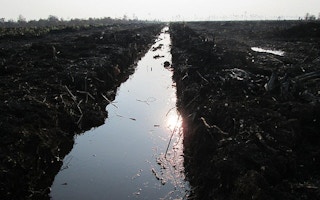The greatest concentrations of the world’s soil carbon have been pinpointed by researchers − and much of it is a dangerously flammable addition to climate change concerns.
An international scientific survey of peat bogs has calculated that they contain more carbon than all the world’s forests, heaths and grasslands together − and perhaps as much as the planet’s atmosphere. Since peat can smoulder underground for years, it is another potential factor in global warming calculations.
Peat is simply leaf litter that never completely decayed. Ancient peatlands become distinctive ecosystems and, in some places, an economic resource.
Soil carbon
Merritt Turetsky, an ecosystem ecologist at the University of Guelph, Ontario, and colleagues report in Nature Geoscience that peatlands cover between only 2 per cent and 3 per cent of the planet’s land surface, but store 25 per cent of the planet’s soil carbon.
In the high latitudes of the northern hemisphere, they cover about 4 million sq km and store between 500 and 600 billion tonnes of carbon. In the tropics – and especially in south-east Asia – they cover about 400,000 sq km and store 100 billion tonnes of carbon. The entire pool of atmospheric carbon, in the form of carbon dioxide, adds up to about 850 billion tonnes.
In its pristine condition, a peat bog is unlikely to burn: the peat exists because vegetation doesn’t decay normally in water.
“
The tropical peatlands of South-east Asia are a clear demonstration of how human activity can alter the natural relationships between ecosystems and fire
Susan Page, professor of physical geography, University of Leicester, UK
But, over thousands of years, humans have drained the peat bogs, exploited them for fuel, and even used peat as a gardening mulch. Dry peat burns easily, and some of the largest fires on Earth are now in the drained peatlands.
“When people think of a forest fire, they probably think of flames licking up into treetops, and animals trying to escape,” Dr Turetsky says. “But peat fires tend to be creeping ground fires. They can burn for days or weeks, even under relatively wet conditions. They lack the drama of flames, but they produce a lot of smoke.”
The research by Canadian, British, Dutch and US scientists is part of a wider global attempt to understand the carbon cycle.
Global warming happens because more carbon goes into the atmosphere as carbon dioxide than plants in the oceans and on land can absorb. So it makes sense to work out in fine detail where the carbon comes from, and how it is soaked up by living things.
Enduring hazard
Peat fires are an enduring hazard, and a local threat to human health. But in a warming world, in which the human population has trebled in one lifetime, the peatlands are drying out, and could fan the flames of climate change.
Once started, peat fires are hard to stop. Fire in the treetops can race across the forest at 10 kilometres an hour, while smouldering peat can take a week to travel half a metre. But both can happen at once, the scientists report.
“The tropical peatlands of South-east Asia are a clear demonstration of how human activity can alter the natural relationships between ecosystems and fire,” said Susan Page, professor of physical geography at the University of Leicester, UK, and a co-author of the latest report.
In a Nature study in 2002, she calculated that a dramatic and sustained forest fire in Indonesiain 1997 may have sent 2.5 billion tonnes of carbon into the atmosphere – a figure that could have added up to 40 per cent of all the emissions from all the fossil fuel burning that year.
“Tropical peatlands are highly resistant to natural fires, but in recent decades humans have drained peatlands for plantation agriculture,” she said. “People cause the deep layers of peat to dry out, and also greatly increase the number of fire ignitions. It’s a double threat.”










